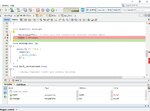ric323pbtstgc
Newbie level 6

- Joined
- May 14, 2009
- Messages
- 12
- Helped
- 1
- Reputation
- 2
- Reaction score
- 6
- Trophy points
- 1,283
- Location
- Melbourne, Australia
- Activity points
- 1,361
So you should have changedI have 20 MHZ externa crystal
#define _XTAL_FREQ 8000000
to
#define _XTAL_FREQ 20000000
which I see you have now done.
"through a cable" is not "directly".I am connecting USB-RS232 adaptor directly through a cable
Are you sure this is a "straight though" cable?
i.e. every pin at one end connects to the same pin at the other end?
"Null modem" cables are also common, which swap the TX and RX pins from one end to the other.






